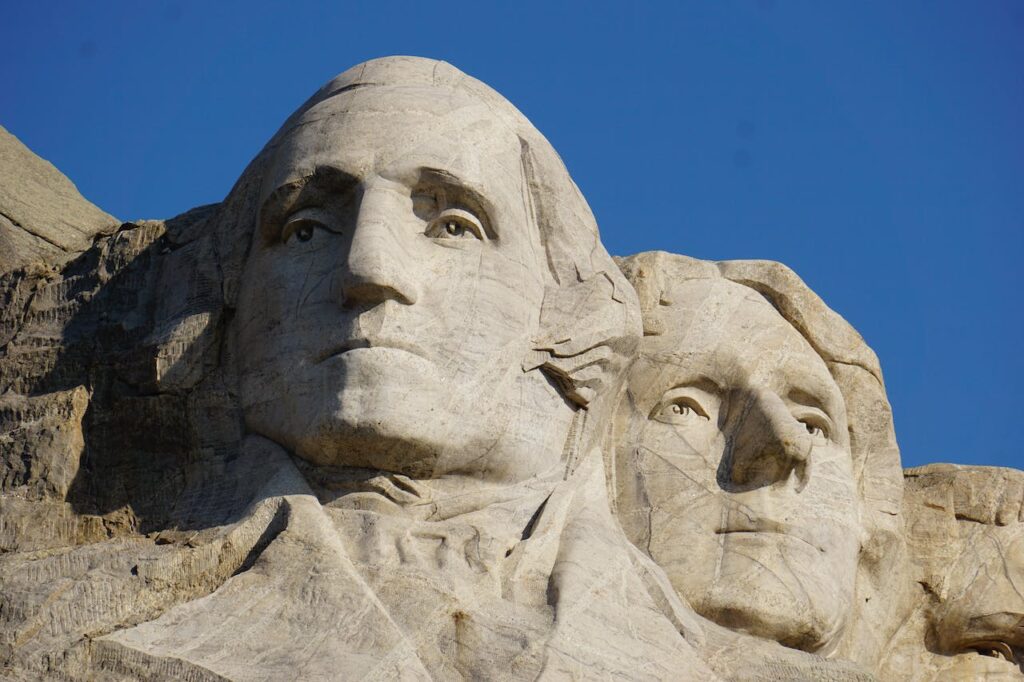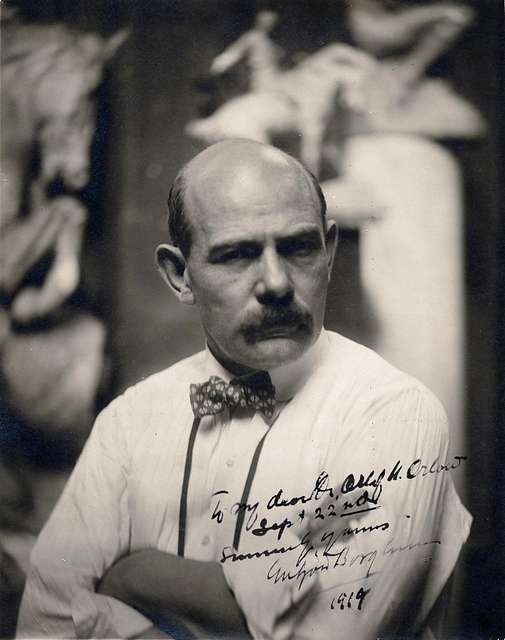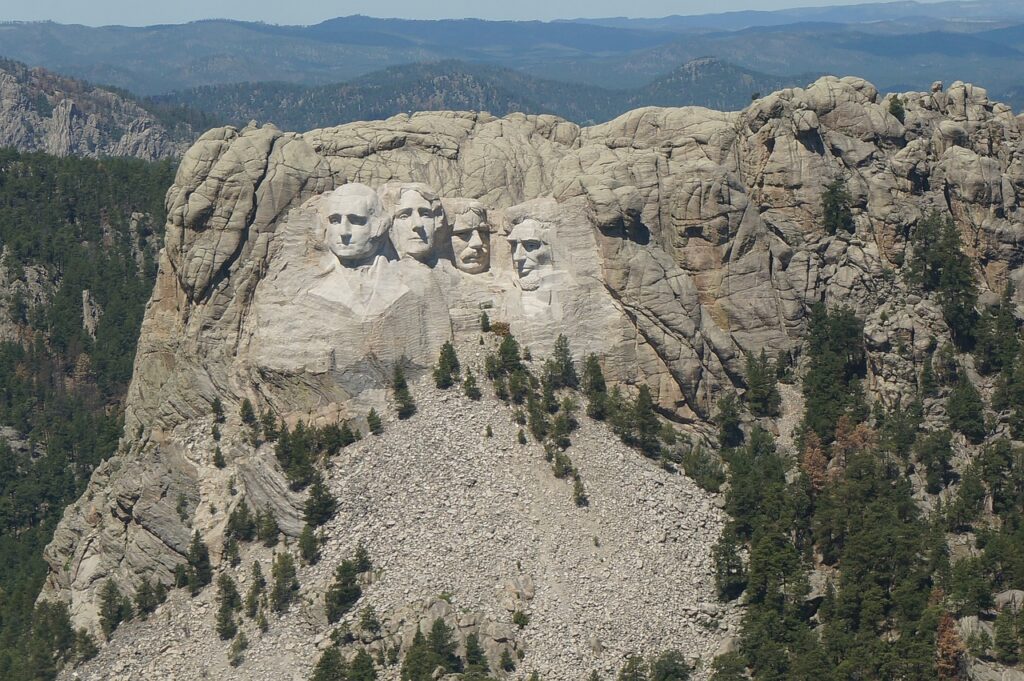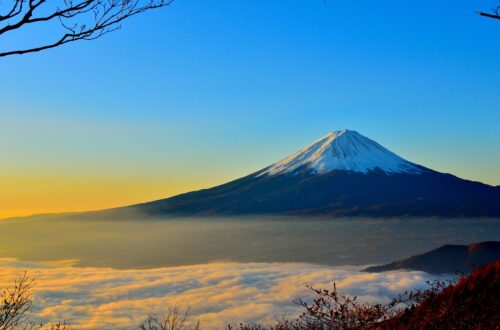
Astonishing Facts About Mt. Rushmore (The Best 53)
Facts About Mt. Rushmore
Firstly Mount Rushmore is an emblem of national pride, standing tall amidst the Black Hills of South Dakota. But beyond the colossal faces of George Washington, Thomas Jefferson, Abraham Lincoln, and Theodore Roosevelt, lies a trove of intriguing facts and stories. Join us as we embark on a journey to uncover the lesser-known “facts about Mt. Rushmore” and the unique history surrounding this grand monument.
The Visionaries Behind the Colossal Sculpture
The Inspiration of Doane Robinson
In the early 1920s, South Dakota state historian Doane Robinson conceived an ambitious idea: a colossal sculpture to attract more tourists to the region. While Robinson’s original idea wasn’t to carve presidents, he envisioned figures like Susan B. Anthony, Buffalo Bill Cody, and native leaders like Red Cloud. It was the talented American sculptor, Gutzon Borglum, who later redefined this vision to feature U.S. presidents.
Facts About Mt. Rushmore
Why These Four Presidents?
- George Washington: Recognized as the first president of the United States. His face was sculpted to symbolize the birth of a nation.
- Thomas Jefferson: The third president of the United States. He was chosen for his role in the Louisiana Purchase. And for penning the text of the Declaration of Independence.
- Abraham Lincoln: Honored for his leadership during the Civil War and his endeavors to preserve the nation.
- Theodore Roosevelt: Celebrated for his hand in the Panama Canal’s construction and championing the National Park Service.

The Evolution of Mt. Rushmore’s Design
The Original Plan
Mt. Rushmore’s design underwent multiple revisions. Gutzon Borglum’s initial plans included carving the presidents from head to waist. However, due to funding issues (especially from the federal government) and challenges with the granite rock face, only the heads were completed.
Incorporating the Hall of Records
An interesting fact about Mt. Rushmore many are unaware of is the Hall of Records. Indeed Borglum’s vision was to house important U.S. documents, like the Declaration of Independence and the Constitution, in a secret room behind Lincoln’s head. Though the hall started, it remains unfinished to this day.
Challenges and Triumphs of the Mount Rushmore Project
Braving the Elements
Carving Mount Rushmore wasn’t just a feat of engineering and artistry. In fact, it was a test against nature. Bad weather, particularly the harsh South Dakota winters, often impeded progress.
Safety and Precision
Despite the dangerous work, with sculptors dangling from Bosun chairs and dealing with tons of rock, no lives were lost during the entire carving of Mount Rushmore. Techniques involved using dynamite for rough carving, and then drills and hammers for finer details.
Did You Know? One of the most surprising “facts about Mt. Rushmore” is that Jefferson’s face was initially pointed to Washington’s right. Due to issues with the stone, it was blasted off and restarted on Washington’s left!

Facts About Mt. Rushmore Conclusion of Part 1 From its inception to the dedication ceremony, Mt. Rushmore represents more than just stone faces; it embodies years of American history and the dedication of countless individuals. Hence as we’ve delved into these initial insights, we’re merely scratching the surface of the intriguing “facts about Mt. Rushmore.” Stay tuned as we explore more about this iconic monument.
[Source for the fact about Jefferson’s face: “Mount Rushmore National Memorial.” National Park Service.]
The Environmental and Cultural Landscape of Mt. Rushmore
Amidst the Ponderosa Pines
Mount Rushmore, the National Memorial isn’t just about the colossal sculpture. Furthermore, it’s nestled in the heart of the Black Hills of Keystone, surrounded by a dense forest of Ponderosa pines. Thus thee aroma from these trees, often referred to as the “vanilla of the Black Hills,” envelops the entire memorial, providing a serene and aromatic backdrop for visitors.
Wildlife Encounters
Without a doubt, the region around Mount Rushmore thrives with wildlife. For instance, Mule deer frequently roam the grounds, offering visitors a chance to witness these majestic creatures in their natural habitat. The Presidential Trail, which winds around the monument, is not just a path to admire the colossal sculptures, but also an opportunity to connect with nature.
The Native Americans and Mt. Rushmore
The Black Hills of South Dakota hold deep spiritual significance for the Lakota Sioux Native American tribe. The mountains are considered sacred, and their history with the U.S. government is intricate and complex, especially concerning treaties like the Treaty of Fort Laramie. Before being recognized as a national monument celebrating U.S. presidents, the Black Hills was, and still is, a spiritual haven for the Lakota people.
The Controversy of the Crazy Horse Memorial

Not far from Mt. Rushmore stands another colossal mountain carving, the Crazy Horse Memorial. In contrast, it’s being sculpted in honor of the Native American leader Crazy Horse and is a response to Mt. Rushmore from the native community. While both memorials have their significance, they also represent two contrasting narratives in the history of the United States.
The Secrets and Hidden Treasures
The Mysterious Hall of Records
As previously mentioned, the Hall of Records was Borglum’s vision to house significant U.S. documents. Though it remains unfinished, the hall remains a topic of interest for many. Rumors of a “secret room” behind the presidential faces often circulate, adding to the monument’s mystique.
The Visitor Center and Lincoln Borglum Museum
The visitor facilities at Mt. Rushmore are more than just information booths. The Lincoln Borglum Museum, named after Gutzon Borglum’s son who continued the project after his father’s death, provides an immersive experience. It showcases the history, challenges, and engineering marvels associated with the carving of Mount Rushmore. Original tools, dynamite techniques, and even a scaled model of the initial plans can be found here.
A Hub of Activities
Grand View Terrace and the Evening Lights
The Grand View Terrace offers the most unobstructed view of the monument. Every evening, a lighting ceremony takes place, illuminating the faces in a breathtaking display. This event, coupled with the backdrop of the vast South Dakota sky, creates an unforgettable experience for spectators.
Dedication and Celebrations
Mt. Rushmore has witnessed several significant events since its completion. The dedication ceremony for each president’s face was a grand affair, attended by thousands, including President Calvin Coolidge for the dedication of Washington’s face. These ceremonies not only celebrated the completion of each face but also the ideals and achievements of the respective presidents.
The Monument’s Role in Popular Culture
Over the years, Mt. Rushmore has cemented its place in popular culture. From being a backdrop in movies to its depiction on U.S. postage stamps, the monument has become a symbol of national pride and identity.
In Conclusion of Part 2 As we venture deeper into the “facts about Mt. Rushmore,” it becomes evident that the monument is more than a testament to presidential legacy. It stands at the crossroads of culture, history, nature, and artistry, making it a multifaceted jewel in the crown of U.S. national parks.
Stay with us as we continue this enlightening journey with more facts about Mt. Rushmore,
Beyond the Faces: The Lesser-known Chronicles of Mt. Rushmore
A Herculean Task: Funding the Dream
The carving of Mount Rushmore was not just a test of skill, but also of endurance, especially when it came to securing funds. The federal government, including the National Park Service, played a significant role in the project’s funding. However, the Great Depression posed numerous challenges. It was the relentless pursuit of both Borglum and Senator Peter Norbeck to secure federal funding that kept the project afloat. Their efforts culminated in President Calvin Coolidge’s support, which was instrumental in acquiring the necessary federal funds.
Stone Mountain: The Borglum Connection
Before his involvement in the Mount Rushmore project, Gutzon Borglum had worked on the colossal Confederate Memorial Carving at Stone Mountain in Georgia. However, due to conflicts with the sponsors, Borglum was fired from the project. This experience, though fraught with challenges, was a precursor to his magnum opus at Mount Rushmore.
The Men Behind the Mountain
While Borglum is rightfully credited as the visionary behind Mt. Rushmore, the project’s success was the collective effort of over 400 workers. These individuals, many of whom were miners from the nearby areas, dangled from the granite face in bosun chairs, skillfully using dynamite and jackhammers. They faced potential dangers every day, from falling rocks to the perils associated with handling explosives. Yet, their dedication ensured that not a single life was lost during the project’s duration.
The Fifth Face Debate

An interesting aspect of the “facts about Mt. Rushmore” is the debate about adding a fifth face. Over the years, various campaigns have proposed figures like Susan B. Anthony and Ronald Reagan. While this debate stirs emotions and discussions, the U.S. government has made it clear that no additions will be made to preserve the monument’s integrity.
Interesting Facts About Mt. Rushmore: Who Was Susan B. Anthony
Susan B. Anthony (February 15, 1820 – March 13, 1906) was a pivotal figure in the women’s suffrage movement in the United States. Here’s a brief overview of her contributions:
- Early Life and Activism: Born in Adams, Massachusetts, into a Quaker family, Susan B. Anthony was raised in an environment that valued activism, social justice, and equal rights. This upbringing profoundly influenced her convictions and activism in later life.
- Women’s Suffrage: Anthony is best known for her tireless work advocating for women’s right to vote. She believed that achieving the right to vote was paramount for women to influence public policy and ensure their rights.
- Partnership with Elizabeth Cady Stanton: Teaming up with Elizabeth Cady Stanton, another significant figure in the women’s rights movement, Anthony traveled extensively, giving speeches and lobbying for women’s suffrage. The two of them co-founded the National Woman Suffrage Association (NWSA) in 1869.
- Civil Disobedience: In a bold act of civil disobedience, Anthony voted in the 1872 presidential election, knowing full well that it was illegal for women to do so at the time. She was arrested and fined $100, a fine she defiantly never paid.
Interesting Facts About Mt. Rushmore: Who Was Susan B. Anthony
- Publications: Along with Stanton and Matilda Joslyn Gage, Anthony co-edited the first three volumes of the six-volume series “History of Woman Suffrage.” This work documented the events, activism, and personalities of the women’s suffrage movement.
- Legacy: Susan B. Anthony’s relentless efforts and advocacy laid the groundwork for the eventual ratification of the Nineteenth Amendment in 1920, which granted women the right to vote. Unfortunately, she did not live to see this day, as she passed away in 1906.
- Remembering Anthony: In recognition of her monumental contribution to the cause of women’s rights, the U.S. Treasury Department minted a Susan B. Anthony dollar coin in 1979, making her the first woman to be depicted on a circulating U.S. coin.
In essence, Susan B. Anthony’s life was characterized by unwavering dedication to the causes she believed in, notably women’s suffrage. Her legacy continues to inspire activists and feminists today, as they push for equality and social justice in various fields.
Facts About Mt. Rushmore

Nearby Attractions: Custer State Park and Wind Cave National Park
Visitors to Mount Rushmore often extend their journey to nearby attractions. The Custer State Park, known for its scenic beauty and wildlife, is a haven for nature enthusiasts. The Wind Cave National Park, boasting one of the world’s longest caves, offers an underground adventure filled with intricate formations.
Rushmore Peak: The Mountain’s Namesake
Many wonder how the mountain got its name. It was christened after Charles E. Rushmore, a New York lawyer who visited the Black Hills during an expedition in the 1880s. Despite its majestic sculptures, locals still fondly remember its initial identity tied to Rushmore.
Reflections on America’s Journey
Each president’s face on Mount Rushmore symbolizes a unique chapter in the nation’s history. George Washington represents the nation’s birth, Jefferson its expansion, Lincoln its preservation through civil strife, and Roosevelt its development and global standing. Together, they encompass over 130 years of American history, from the nation’s founding to the brink of its rise as a global power.
Preserving the Legacy: Modern Conservation Efforts
Like all monumental structures, Mount Rushmore faces the test of time. The National Park Service, responsible for the monument’s upkeep, undertakes regular maintenance to ensure the sculptures remain pristine. Modern technology, like digital scanning, helps monitor erosions or potential damages.
In Conclusion, Part 3 The tapestry of stories and “facts about Mt. Rushmore” continues to fascinate and inspire. It is not merely a destination but a journey through the annals of American history, a testament to the human spirit, tenacity, and the relentless pursuit of dreams.
Interested in Rock? Then read my Interesting Facts About Rock
Mount Rushmore: Symbols and Significance in the American Landscape
The Unending Debate: Environmental Impact and Conservation
The decision to carve the faces of four presidents into the granite of the Black Hills wasn’t without controversy. The region, once a sanctuary to the Lakota Sioux Native American tribe, has undergone significant environmental changes. While Mount Rushmore attracts millions of visitors annually, increasing tourism also brings challenges in terms of conservation. Balancing the needs of a top tourist destination with those of the natural environment remains a priority for the National Park Service.
The Visionary’s Offspring: Lincoln Borglum’s Legacy
When Gutzon Borglum passed away in 1941, the carving of Mount Rushmore was yet to be completed. His son, Lincoln Borglum, took up the mantle. Even though the original idea had been his father’s dream, Lincoln ensured its realization. Under his supervision, the project reached its completion later that same year. Today, alongside the monument stands the Lincoln Borglum Museum, a testament to both the visionary and the executor, providing a deeper look into the sculpting process, the tools used, and the challenges faced.

The Unsung Heroes: Recognition of the Workers
One of the fascinating “facts about Mt. Rushmore” is the diversity and dedication of the workforce that made Borglum’s vision a reality. These men, often overlooked in the grand narrative, played pivotal roles. They endured long hours, dangerous conditions, and bad weather, dangling hundreds of feet above the ground. Their expertise in using dynamite sculpted the rough contours of the presidents’ faces, removing tons of granite before the finer details could be carved. Today, a plaque at the site honors these unsung heroes, ensuring their legacy is remembered.
Facts About Mt. Rushmore
Mount Rushmore in Global Perspective
While Mount Rushmore is an American icon, its significance resonates globally. The ideals represented by the four presidents echo worldwide aspirations for freedom, democracy, and progress. Over the decades, it has inspired numerous other countries to undertake similar monumental projects, showcasing their national heroes and historical narratives.
The Textual Connection: Declaration of Independence and the Louisiana Purchase
Jefferson’s face on Mount Rushmore doesn’t only symbolize his tenure as the third president of the United States. It’s a nod to the Declaration of Independence’s author and the Louisiana Purchase’s orchestrator. These events, foundational in shaping the U.S., have left an indelible mark on its history.
The Red Cloud Reconciliation
The history of Mount Rushmore cannot be separated from the history of the Native Americans in the region. Red Cloud, a prominent Lakota chief, was a symbolic figure who resisted U.S. government policies. Thus today, efforts are ongoing to promote reconciliation, understanding, and mutual respect between Native American communities and the broader American public.
The Panorama from the Grand View Terrace
For those who visit Mount Rushmore, the Grand View Terrace provides an unparalleled vantage point. Here, against the backdrop of the vast South Dakota sky and the surrounding Ponderosa pines, one can reflect on the nation’s history, the monument’s significance, and the intertwined fates of all those who have called this land home.
Conclusion of Part 4 Mount Rushmore stands as a confluence of art, history, politics, and nature. Moreover each chisel mark, each blast, and every “fact about Mt. Rushmore” is a testament to America’s complex and evolving narrative. As we gaze upon the faces of the four presidents, we are reminded not only of their legacies but of the collective journey of a nation and its people.
Facts About Mt. Rushmore: More Than Just Stone
Secrets in Stone: The Hall of Records
Did you know one of the most intriguing “facts about Mt. Rushmore” is the existence of the Hall of Records? Initially conceptualized by Borglum, this chamber was meant to house pivotal U.S. documents, including the Declaration of Independence and the Constitution. Though the hall was never fully realized due to funding issues, a titanium vault with these texts was eventually placed in the chamber in the 1990s, ensuring that future generations would understand the monument’s significance.
Mount Rushmore’s Neighbor: The Crazy Horse Memorial
A short drive from Mount Rushmore lies another colossal sculpture, the Crazy Horse Memorial. Indeed intended to honor Crazy Horse, a Lakota warrior, and all Native Americans, this ongoing project is a response to Mount Rushmore, embodying the Native American narrative in the history of the United States. Though still incomplete, it’s a testament to the region’s rich tapestry of stories and histories.
Reverberations of Time: The Sea Level Marker
An often overlooked “fact about Mt. Rushmore” is the sea level marker located nearby. In fact, this geodetic control point indicates the height above sea level and serves as a testament to the intricacies and precision involved in the project. This marker is a reminder that while the monument celebrates political figures and ideals, it also intertwines with the scientific advancements of its time.
Mount Rushmore’s Cultural Cameos
From films to TV commercials, Mount Rushmore has found its way into popular culture, often symbolizing American pride, heritage, or ambition. Whether it’s Cary Grant and Eva Marie Saint scaling Thomas Jefferson’s face in Alfred Hitchcock’s “North by Northwest” or a casual reference in animated shows, the monument’s visage in media underscores its enduring cultural significance.
The Evolution of Visitor Facilities
Over the years, visitor facilities at the Mount Rushmore National Memorial have evolved to cater to the increasing influx of tourists. The visitor center, presidential trail, and various viewpoints ensure that everyone, regardless of physical ability, can experience the magic of the colossal sculptures. Moreover, interactive exhibits provide deeper dives into the history and making of this American icon.
Nature’s Inhabitants: Wildlife around Mount Rushmore

While the granite faces are the primary draw, the surrounding Black Hills teem with life. Indeed Mule deer wander through the forests, and the chirps of birds reverberate through the Ponderosa pines. Visitors are often delighted by the surprise appearance of mountain goats, which, despite being non-native, have made the rocky outcrops their home. This vibrant ecosystem serves as a reminder that Mount Rushmore is not just a celebration of human achievement but also a testament to nature’s resilience and beauty.
Facts About Mt. Rushmore
The Contemplative Space: The Avenue of Flags
Walking through the Avenue of Flags, visitors are flanked by flags from all 50 states, the District of Columbia, Guam, Puerto Rico, American Samoa, the Virgin Islands, and the Northern Mariana Islands. This pathway is not only a tribute to the nation’s unity but also a space of reflection. Thus each flag fluttering in the breeze symbolizes the hopes, dreams, and diverse stories of the American populace.
The Legacy Continues: Future Generations and Mount Rushmore
The “facts about Mt. Rushmore” resonate differently with each generation. For some, it’s a symbol of national pride, while for others, it’s a reminder of historical injustices. However, as America continues to grapple with its multifaceted history, Mount Rushmore stands as a focal point for dialogue, reflection, and understanding. Future generations will undoubtedly interpret and interact with the monument in ways we cannot yet foresee, ensuring its relevance for years to come.
Facts About Mt. Rushmore Concluding Thoughts
Mount Rushmore, beyond its granite grandeur, is a living narrative. It is a story of ambition, artistry, national identity, and the ever-evolving understanding of history. Each “fact about Mt. Rushmore” adds a layer to this intricate tale. As the sun sets behind the Black Hills of Keystone, casting the faces of the four presidents in a golden hue, one can’t help but reflect on the monument’s journey and its enduring place in the American psyche.

For more American History read The Best 25 Interesting Facts About Georgia Colony
Frequently Asked Questions (FAQs) Facts About Mt. Rushmore
Who are the four U.S. presidents depicted on Mount Rushmore?
The four presidents carved into the granite of Mount Rushmore are George Washington, Thomas Jefferson, Theodore Roosevelt, and Abraham Lincoln.
Why was Mount Rushmore created, and what does it symbolize?
Mount Rushmore was created as a “Shrine of Democracy” to promote tourism in South Dakota and to commemorate the nation’s birth, growth, development, and preservation, as represented by the four presidents. Each president was chosen for their respective roles in these phases of American history.
What is the Hall of Records at Mount Rushmore?
The Hall of Records is an incomplete chamber behind the faces of Mount Rushmore. Initially conceived by sculptor Gutzon Borglum, it was meant to house significant U.S. documents. While the chamber was never fully realized, a titanium vault with texts like the Declaration of Independence was placed in the chamber in the 1990s.
How does the Crazy Horse Memorial relate to Mount Rushmore?
The Crazy Horse Memorial, still under construction, is located a short distance from Mount Rushmore. It’s being carved in honor of the Lakota warrior Crazy Horse and all Native Americans. It can be seen as a response to Mount Rushmore, representing the Native American narrative in the U.S. history.
How has Mount Rushmore impacted the environment and local Native American tribes?
The creation of Mount Rushmore in the Black Hills, sacred to the Lakota Sioux, has long been a point of contention. The monument’s construction and increasing tourism have brought both economic benefits and environmental challenges. Balancing the site’s significance with the rights and sentiments of the Native American communities remains a focal point of discussions.
Who Was Charles E. Rushmore
Charles E. Rushmore was a New York City attorney who played a noteworthy, albeit indirect, role in the history of Mount Rushmore. During a business trip to the Black Hills of South Dakota in the 1880s, Rushmore asked a local guide about the name of a particular mountain in the area. At the time, the mountain did not have an official name, so the guide humorously told him it would be named “Rushmore” in his honor. The name stuck, and the mountain eventually became officially known as Mount Rushmore.
It’s a delightful twist of fate that this mountain, initially named in a somewhat offhand manner, would later become the site for one of the most iconic national monuments in the United States. The massive sculpture on Mount Rushmore, featuring the faces of four U.S. presidents, was carved between 1927 and 1941.
Despite Charles E. Rushmore’s connection to the mountain’s name, he had no direct involvement in the conception or creation of the Mount Rushmore monument.





One Comment
Pingback: